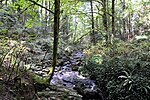George Rogers House (Lake Oswego, Oregon)
1929 establishments in OregonBuildings and structures in Lake Oswego, OregonHouses completed in 1929Houses in Clackamas County, OregonNational Register of Historic Places in Clackamas County, Oregon

George Rogers House is a private home in Lake Oswego, Oregon, United States. Located at the corner of Durham Street and Wilbur Street, the house was the home of George Rogers, who donated the land to the City of Lake Oswego that became George Rogers Park. During the time that Lake Oswego was an industrial town, the park was the location of Lake Oswego's China Town district. Built in 1929, the two-story craftsman house was added to the United States National Register of Historic Places listings in 1996.
Excerpt from the Wikipedia article George Rogers House (Lake Oswego, Oregon) (License: CC BY-SA 3.0, Authors, Images).George Rogers House (Lake Oswego, Oregon)
Wilbur Street,
Geographical coordinates (GPS) Address Nearby Places Show on map
Geographical coordinates (GPS)
| Latitude | Longitude |
|---|---|
| N 45.41315 ° | E -122.66292 ° |
Address
Wilbur Street 59
97034
Oregon, United States
Open on Google Maps









